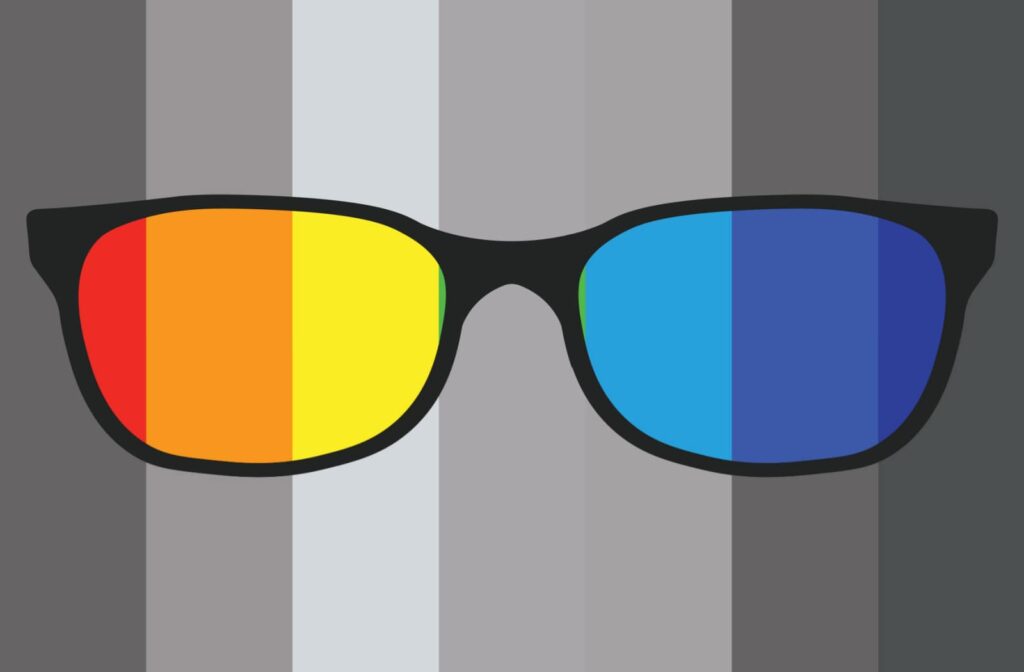People love colors. We have favorites, decorate and dress with colors we think are flattering, and appreciate the beauty of nature’s palette. The invention of color television was exciting because it made media more realistic, artistic, and entertaining.
But some people have color blindness—also called color deficiency—and experience color differently. Color vision refers to the ability to see color, while color blindness is a partial or complete fault in color vision.
Some people affected by color blindness find their colors get mixed up, appear less vivid, or are absent altogether. During your eye exam, our optometrists at Perry & Morgan EyeCare can test your color vision to identify color deficiency or a change in color vision early.
Understanding Color Vision & Color Blindness
How Color Vision Works
How do we perceive color? The eyes and brain work together to transform light into colors. Light journeys to the retina at the back of the eye, which is covered by light-receptive cells—rods and cones.
Rods transmit primarily black and white information to the brain via the optic nerve, while cones transmit color information. Cones are sensitive to the different wavelengths of light that make up color. Each cone found in the macula is sensitive to primary colors: red, green, and blue light.
If these cones don’t work or are absent, distinguishing between colors can become difficult, leading to color deficiency.
Different Types of Color “Blindness”
A common misconception surrounding color blindness is the use of the word “blindness”. Color deficiency is a preferred term because those with color “blindness” often perceive colors— they just don’t see them as others do.
There are 3 common types of color blindness: red-green, blue-yellow, or complete color deficiency (achromatopsia).
Red-green color deficiency is the most common and can affect the eyes differently, depending on which subtype you have. Some of the ways it can affect your vision include the following:
- It can make green look red
- It can make red look green and muted
- You may be unable to differentiate the two colors entirely
Blue-yellow color deficiency is less common and can make distinguishing between blue and green and between yellow and red difficult. It can also cause a shift in perception between blue and green, purple and red, and yellow and pink while making colors appear dim.
Complete color blindness (achromatopsia) is rare. In those cases, you can’t see colors at all. This is also called monochromacy, it can cause unclear vision and intense sensitivity to light.
Causes of Color Blindness
The majority of those with color deficiency are born with it – it is in the genes. Gender can be a risk factor for color deficiency in its congenital form, but color blindness can also occur later in life due to:
- Vascular disease
- Metabolic disease
- Effects of medications
- Excessive alcohol consumption (Alcohol Use Disorder)
- Trauma
Certain health conditions can elevate your risk of developing color deficiency, such as:
- Sickle cell anemia
- Leukemia
- Alzheimer’s disease
- Parkinson’s disease
- Glaucoma
- Diabetes
- Age-related macular degeneration
People with color deficiency may not realize they have it, so it’s critical to get color vision tested in a comprehensive eye exam.

How to Test for Color Blindness
Color vision tests are usually simple—you look at images with numbers or letters surrounded by dots of color. The background color is different than the shade of the character. If you can correctly tell the two colors apart, your color vision is functioning well, but if you perceive the colors differently or it’s hard to distinguish them, that can be a sign of color deficiency.
There are alternative versions of the test for preschool-aged children who can’t identify letters or numbers, so color deficiency can be identified at an early age.
Treatment for Color Blindness
No one should miss out on all the colors the world has to offer. EnChroma lenses are specialty eyewear that use revolutionary advances in eye care to help those with color blindness see in full color.
EnChroma lenses work by filtering light wavelengths at the point where there is too much of an overlap of cone sensitivities. By filtering different wavelengths of light, these lenses can help the wearer experience more of the broad spectrum of color.
For some people who experience color deficiency, EnChroma lenses can offer a new perspective on color and the world around them.
Experience Complete Color Vision
Colors can be relaxing, energizing, and uplifting, representing every emotion on the spectrum. You don’t need to be an artist to appreciate color, and now, experiencing color vision previously out of reach is possible for those affected by color deficiency.
Schedule an appointment for a comprehensive eye exam to discuss how color deficiency affects your vision. Our doctors at Perry & Morgan EyeCare can assess your color vision and determine how innovative EnChroma lenses may be able to boost your perception of color.



